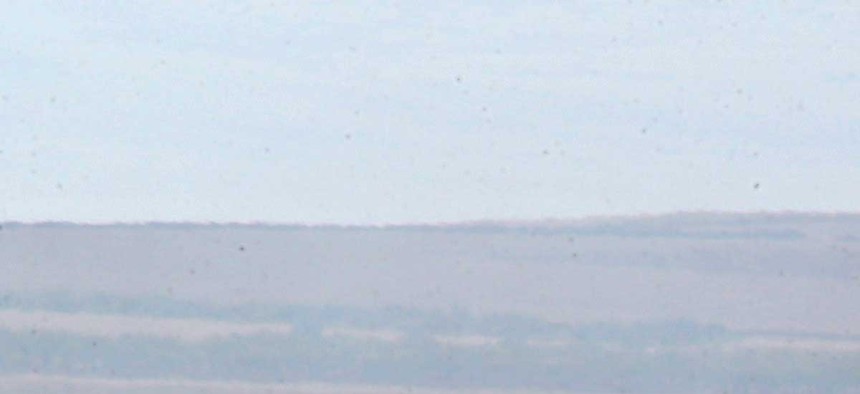
Turkish soldiers hold their position in a tank on the outskirts of Suruc, at the Turkey-Syria border, near the town of Kobani. Lefteris Pitarakis/AP
Promises of Syrian Rebel Train-and-Equip Program Meet the Battlefield’s Realities
It will take months, if not years, to train and equip Syrian rebels. But on the battlefield, the clock is ticking. By Gayle Tzemach Lemmon
As the fight for the key Syrian border town Kobani unfolds in real time before the world, the limits of U.S. military involvement are on stark display as well.
“Airstrikes alone are not going to do this. They're not going to fix this. They're not going to save the town of Kobani,” Pentagon spokesman Adm. John Kirby said Wednesday. “The ground forces that have to -- that matter the most are indigenous ground forces. And we don't have a willing, capable, effective partner on the ground inside Syria right now. It's just a fact.”
Another fact: the urgency of getting help, including weapons and ammunition, to Syrian rebel forces has now collided with the reality of the timeline for vetting those fighters and establishing the train-and-equip program in Saudi Arabia.
And for those supporting the rebel fighters against the Islamic State, the clock is ticking.
“The opposition is asking to expedite the train-and-equip program, but particularly the equip. You have a battle force already on ground that is training on the field,” said Oubai Shahbandar, strategic communications adviser to the Syrian Coalition. “The training program is very important and part of a long-term program with U.S. and Saudi Arabian allies, but you need ammunition and you need ammunition fast. That is what stopped ISIS from overrunning Irbil and that is what is going to help FSA [Free Syrian Army] and Sunni tribes to hit ISIS at its exposed flank on the Syrian side of the border.”
In congressional testimony last month, Joint Chiefs Chairman Gen. Martin Dempsey said the train-and-equip effort would take up to five months to launch. He also said a year might pass before the recruit, vet and prepare cycle was completed.
The question is what the war will look like by then?
“Two clocks are ticking at different speeds,” said Janine Davidson, who served from 2009 to 2012 as deputy assistant secretary of defense for plans. “It takes a certain amount of time to train people and equip them, and the question is what sorts of facts on the ground will be changed by the time they are able to get in there and do anything. How many more villages will get taken?”
Right now Kobani is just one of the towns that sit in ISIS crosshairs. As the Pentagon has acknowledged, others are likely to fall while cameras roll. In the meantime, those standing with Syrian rebel forces say there’s little time to waste.
“U.S. airstrikes are going to buy us time and the ongoing military aid program led by U.S. and moderate Arab allies is going to buy us time, but we also need excess military defense articles, particularly ammunition from DOD stocks that are available in the region,” Shahbandar said. Right now Free Syrian Army forces are seeking help to fight ISIS in northern and eastern Syria.
The Syrian opposition met with Ret. Gen. John Allen, the State Department’s special envoy in the fight against ISIS, and other U.S. officials in recent days and shared the view that they are ready to get moving now. Sheikh Ahmad al-Jarba, who formerly led the Syrian Opposition Coalition, met in Amman with Allen, Deputy Assistant Secretary of State Brett McGurk, and Special Envoy to Syria Daniel Rubenstein and talked about creating coordination and cooperation channels between the anti-ISIS coalition and the Syrian opposition. They want to connect the coalition in Iraq fighting ISIS with their aligned fighters in Syria.
They have a long fight ahead. Administration officials say that inside the White House the two fights, while linked, are still seen in many ways as distinct. Syria is viewed as far messier, which is part of the reason the U.S. avoided intervening in the worsening conflict for so long.
“In Syria we are doing some strikes but we are not addressing the root cause, the source of that problem,” said an administration official, speaking about the approach to the regime of Syrian President Bashar al-Assad. “They are just going to try to manage ISIS in Syria and contain it in Iraq.”
The hope is that once the train-and-equip is up and running in Saudi Arabia, it will grow and win further financial support from the U.S. – and key Arab allies.
But, as Kirby noted at the Pentagon, “in Syria, right now we just don't have a ground force that we can work with. I understand that there are fighters and they are brave and we recognize the sacrifices they are making, but we don't have -- military-to-military -- we don't have a force inside Syria that we can cooperate with and work with. That's why we want to get this train-and-equip program up and running.”
A year from now, what that ground force faces may look much different than today. And the next administration will face its own decisions on the Syrian conflict.
“Whatever they are putting in place, bureaucratically, authorities-wise, financially and from a strategic perspective will be the inheritance” of whoever wins in 2016, Davidson said.
In the meantime, the battles rage on with U.S. firepower overhead and outnumbered fighters on the ground.




